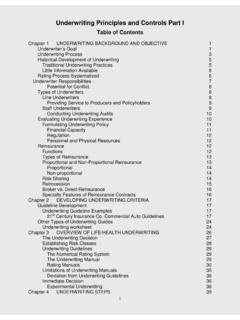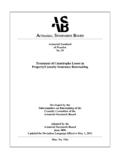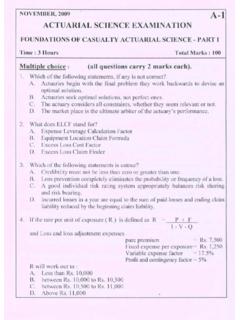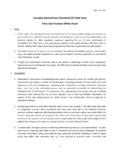Transcription of Reviving PURPA's Purpose: Limits of State Avoided …
1 Reviving purpa S purpose : The Limits of Existing State Avoided Cost ratemaking Methodologies In Supporting Alternative Energy Development and A Proposed Path for Reform Prepared by Carolyn Elefant Law Offices of Carolyn Elefant Washington Contact Info: Carolyn Elefant 202-297-6100 Table of Contents I. OVERVIEW ..1 II. purpa AND FERC ..4 A. purpa OVERVIEW: A UTILITY MUST BUY CAPACITY AND ENERGY FROM "QUALIFYING FACILITIES," PRICED AT THE UTILITY'S Avoided COST .. 4 1. Enactment of purpa .. 5 2. FERC Regulations .. 6 B. FERC RULINGS .. 8 C. EPACT 2005 purpa AMENDMENT .. 10 III. State POLICY CHOICES IN IMPLEMENTATION OF purpa .. 10 A. OVERVIEW OF State POLICY CONSIDERATIONS IN Avoided COST ratemaking .. 11 B. STANDARD OFFER RATES .. 12 C. Avoided COST METHODOLOGIES .. 13 1. Proxy unit .. 17 2. Peaker.
2 18 3. Differential Revenue Requirement (DRR) .. 19 4. Market-based pricing .. 20 5. Competitive Bidding .. 20 6. Avoided cost pricing for energy efficiency programs .. 22 7. Comparison of methodologies .. 23 D. RESOURCE SUFFICIENCY VERSUS RESOURCE DEFICIENCY .. 26 E. DISPATCHABILITY AND MINIMUM AVAILABILITY AS A PRECONDITION TO CAPACITY PAYMENTS .. 28 F. LINE LOSS AND Avoided TRANSMISSION COSTS .. 30 G. EXTERNALITIES AND ENVIRONMENTAL COST ADDERS .. 32 LEVELIZED CONTRACT RATES VERSUS VARYING RATES .. 33 I. REC AVAILABILITY .. 34 DIFFERENTIATION .. 35 IV. FINDINGS AND CONCLUSION .. 36 APPENDIX .. 39 Law Offices of Carolyn Elefant 1 Reviving purpa S purpose : The Limits of Existing State Avoided Cost ratemaking Methodologies in Supporting Alternative Energy Development and A Proposed Path for Reform I. OVERVIEW Because of the inability of independent power producers to sell their efficient and clean electricity into monopoly-controlled markets, Congress in 1978 enacted the Public Utilities Regulatory Policies Act ( purpa ).
3 purpa encouraged the development of alternative power, including renewable energy and cogeneration, by requiring utilities to purchase energy and capacity from qualifying facilities (QFs) at their incremental, or Avoided costs. Regarded as a successful policy tool for renewable energy and cogeneration growth, particularly in states like California, New York and Maine, purpa s impact faltered in the 1990s, as lower natural gas prices and increased competition in wholesale markets, including the introduction of competitive bidding as a way to set Avoided cost rates in some jurisdictions, reduced Avoided cost payments to renewables and cogeneration under purpa . During this time period, however, many states enacted renewable energy policies such as Renewable Portfolio Standards, public benefit funds and green power pricing programs.
4 The policies, along with federal and State tax incentives, helped to revive renewable energy development in the late 1990s even as purpa s influence Congress limited purpa s scope further through an amendment in EPAct 2005 which allows utilities to apply to the Federal Energy Regulatory Commission (FERC) for relief from the mandatory QF purchase obligation upon a showing that QFs have access to competitive markets. FERC subsequently interpreted broadly that all Regional Transmission Organizations (RTOs) provide such competitive markets, thereby limiting purpa s influence to non-RTO regions, primarily in the Southeast and Northwest. In some jurisdictions most recently, California -- utilities have applied for and received at least partial relief from the mandatory purchase obligation under 1 Renewable Energy Policies and Markets in the United States, Eric Martinot, Ryan Wiser, and Jan Hamrin Center for Resource Solutions, at This report is focused on current and historical 2 See FERC Order 681, online at (establishing regulations from relief of purpa obligations, as well as certain rebuttable presumptions regarding competitiveness of markets Law Offices of Carolyn Elefant 2 jurisdictions where relief from the mandatory purchase obligation under purpa has not been granted.)
5 Notwithstanding these developments, the need for alternative-energy power markets remains. purpa , of course, survives, and its influence may increase in the coming decade. A recent FERC decision, Re: California Public Utilities Commission,3 affords states increased flexibility to set resource-specific Avoided cost rates through purpa . Resource-specific rates are expected to offer greater financial support to alternative power than calculation of a single Avoided cost rate based on consideration of all of a utility s energy sources. Other factors may further reinvigorate purpa , including anticipated EPA rules imposing more stringent standards for emissions (which may increase the cost of some conventional power sources)4 , the need for new electric capacity as a result of the expected closure of many old and dirty coal-fired power plants, and predictions of rising energy costs.
6 These recent developments reopen fundamental questions about how purpa should be interpreted through State purpa policies and Avoided cost methodologies. To address these questions, this report undertook a comprehensive review, the first in more than a decade, of the different ways by which State utility commissions calculate Avoided cost rates for QFs under purpa to identify the factors and underlying State policies that account for the broad range of approaches. The report also examined the use of the Avoided cost concept for purposes of energy efficiency programs. Based on this review, the report found that many developers are unable to fully capitalize on purpa s benefits in light of factors such as the complex, Byzantine nature of Avoided cost ratemaking at the State level which makes Avoided cost ratemaking difficult for developers and regulators to fully understand.
7 Further complicating the problem, in some states like Florida, utilities are vested with broad latitude in determining the data inputs for for QFs of under 20 MW or less located within established RTO/ISO footprints discussion). The majority of FERC cases granting relief from the mandatory purchase obligation, including in California, apply only to purchases from QFs of 20 MW or greater. See, , Pacific Gas & Electric et. al., 135 FERC 61,234 (June 16, 2011). 3 133 FERC 61, 059 (2010). 4 See, , As discussed infra, FERC allows states to include the Avoided costs of compliance with emissions regulations in QF rates. Law Offices of Carolyn Elefant 3 Avoided cost calculations which creates inconsistency and puts even more downward pressure on Avoided cost Many jurisdictions, moreover, provide only short-term ( , day ahead or one year) contracts for alternative power, while independent power producers typically need longer-term agreements in order to attract project financing.
8 Collectively, these factors contribute to Avoided cost rates that are inadequate to support combined heat and power (CHP) and renewable development as intended by purpa . In addition, the report also found that FERC s recent decision in California Public Utilities Commission, which allows states to set resource-specific Avoided cost rates, has not yet filtered down to the State level. Only one State surveyed (Montana) offered resource-specific QF Moreover, even though California Public Utilities Commission reaffirmed that states may consider Avoided environmental costs so long as they are not speculative, few states actually do so in setting Avoided cost rates, even though the practice is common in energy efficiency programs. This report concludes that purpa can still serve as an important policy tool for development of small power producers, including renewables and CHP.
9 However, states need additional guidance on which Avoided cost methodologies are most favorable to small power producers7 5 See p. 22 for further discussion. as well as an understanding of the range of options such as resource-specific Avoided cost rates and ability to account for Avoided environmental costs available to them in setting Avoided cost rates. Therefore, this report recommends that FERC, as the agency responsible for developing the regulations that states must follow in calculating Avoided cost rates, conduct a series of technical conferences on purpa and, 6 No other states offering resource-specific QF rates could be located, though at the time this report was prepared, at least two other states, Idaho and Oregon were examining the possibility of resource-specific Avoided cost rates.
10 7 Initially, it was hoped that a model could be developed to quantify the impact of various State policy choices in Avoided cost methodology on QF rates. However, because of the disparities in State methodologies and lack of availability of public data on utility cost information, development of a model was not possible. This type of model could be extremely useful in assisting states in choosing between Avoided cost models, and for that reason, the report recommends that FERC consider undertaking such an analysis. Law Offices of Carolyn Elefant 4 based on input from stakeholders, issue a policy statement to provide additional guidance to states on their options. The report is organized as follows. The report begins with an overview of purpa , as implemented by FERC regulations. Under purpa , states have broad discretion to set Avoided cost rates; however, State methodology must comply with the parameters established by FERC.






